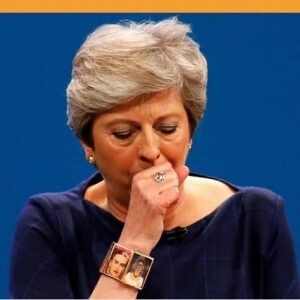Theresa May and Frida Kahlo
Paul Clinton
‘Can I just point out,’ Hannah Jane Parkinson wrote in a widely shared tweet during the Conservative Party Conference, ‘that Theresa May is wearing a bracelet of Frida Kahlo, a member of the Communist party who LITERALLY DATED TROTSKY.’ The Telegraph, though not without making a joke of it, pointed out some of the similarities between the prime minister and the late Mexican artist: their feminism, for example, and their fortitude. Any reference to communism must surely have been a ‘pointed message’ to Jeremy Corbyn, whom the paper styled as an apologist for Trotsky.
Kahlo, a lifelong member of the Communist Party, was for many years ignored by the art historians who revered the political murals of her husband, Diego Rivera. It was only in the 1980s that she gained wide recognition as an artist in her own right, first through the work of feminist art historians. Her image was also adopted by Chicano and queer activists (Kahlo may have been bisexual). Those movements had a complicated relationship with the left wing in the 1980s, which saw identity politics as individualistic rather than concerned with collective struggle, linked to the self-interested culture of the Reagan and Thatcher era.
In 1996, Judith Butler argued that Marxists had too often portrayed struggles over identity as ‘merely cultural’ rather than concerned with questions of material production. Kahlo’s paintings, with their focus on manipulating her own image and borrowing from Mexican folk art, resonated with postmodern preoccupations with artistic appropriation, as well as queer and feminist theories of the construction of gender. Margaret Lindauer has argued that such socially progressive identifications have obscured the specific political and geographic context of Kahlo’s work. Her transformation into a role model, as much as into a commodity used to sell T-shirts, films or, indeed, bracelets, has reduced the artist to her image and biography. That overt references to communism are visible only in a small number of her late works, and that one of her most enthusiastic collectors is Madonna – the queen of either self-fashioning or self-absorption, depending on your point of view – can only have reinforced her association with one type of politics rather than the other.
Kahlo herself wrestled with the question of how her self-portraiture might serve the party cause. ‘I feel uneasy about my painting,’ she wrote in her diary in 1951. ‘Above all I want to transform it into something useful for the Communist revolutionary movement, since up to now I have only painted the earnest portrayal of myself.’ Two years later, she felt she had reconciled these aspects of her painting, believing that her self-transformations demonstrated solidarity with Mexican Indians and by extension all peoples oppressed by ‘capitalist countries, above all North America – the US and England’.
Even if it were possible to leave aside their fundamental political differences, the Kahlo bracelet would have been an odd choice for the prime minister. Kahlo was severely disabled by a bus crash in her youth; under May’s leadership, the UK government’s record on disability rights has been declared a ‘human catastrophe’ by the UN. Kahlo expressed solidarity with Mexicans oppressed by the US; May made an undignified dash to be the first world leader to meet with Donald Trump after his inauguration. Kahlo worried that she was more focused on her emotional turmoil than politics; May took to the stage in Manchester to apologise for appearing ‘too scripted, too presidential’ – before her speech fell apart in a series of unscripted calamities.

Comments